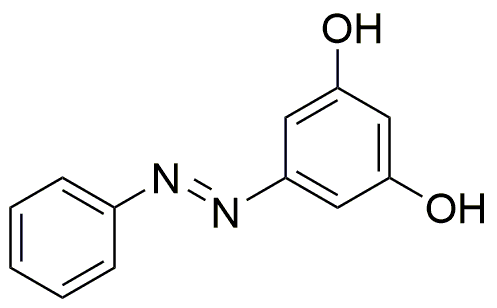Phenylazoresorcinol is widely utilized in research focused on various applications:
- Dyes and Pigments: This compound is commonly used in the textile industry as a dye, providing vibrant colors and excellent lightfastness, making it ideal for fabrics that require durability.
- Analytical Chemistry: It serves as a reagent in analytical procedures, particularly in the detection of metal ions, enhancing the accuracy of chemical analysis in laboratories.
- Biological Research: Researchers utilize it in studies related to cell signaling and cancer research, as it can influence cellular processes, providing insights into therapeutic targets.
- Cosmetics: Due to its coloring properties, it finds applications in cosmetic formulations, offering both aesthetic appeal and functional benefits, such as UV protection.
- Food Industry: It is also explored as a food colorant, where it can enhance the visual appeal of products while meeting safety regulations, making it a preferred choice over synthetic alternatives.
General Information
Properties
Safety and Regulations
Applications
Phenylazoresorcinol is widely utilized in research focused on various applications:
- Dyes and Pigments: This compound is commonly used in the textile industry as a dye, providing vibrant colors and excellent lightfastness, making it ideal for fabrics that require durability.
- Analytical Chemistry: It serves as a reagent in analytical procedures, particularly in the detection of metal ions, enhancing the accuracy of chemical analysis in laboratories.
- Biological Research: Researchers utilize it in studies related to cell signaling and cancer research, as it can influence cellular processes, providing insights into therapeutic targets.
- Cosmetics: Due to its coloring properties, it finds applications in cosmetic formulations, offering both aesthetic appeal and functional benefits, such as UV protection.
- Food Industry: It is also explored as a food colorant, where it can enhance the visual appeal of products while meeting safety regulations, making it a preferred choice over synthetic alternatives.
Documents
Safety Data Sheets (SDS)
The SDS provides comprehensive safety information on handling, storage, and disposal of the product.
Product Specification (PS)
The PS provides a comprehensive breakdown of the product’s properties, including chemical composition, physical state, purity, and storage requirements. It also details acceptable quality ranges and the product's intended applications.
Certificates of Analysis (COA)
Search for Certificates of Analysis (COA) by entering the products Lot Number. Lot and Batch Numbers can be found on a product’s label following the words ‘Lot’ or ‘Batch’.
*Catalog Number
*Lot Number
Certificates Of Origin (COO)
This COO confirms the country where the product was manufactured, and also details the materials and components used in it and whether it is derived from natural, synthetic, or other specific sources. This certificate may be required for customs, trade, and regulatory compliance.
*Catalog Number
*Lot Number
Safety Data Sheets (SDS)
The SDS provides comprehensive safety information on handling, storage, and disposal of the product.
DownloadProduct Specification (PS)
The PS provides a comprehensive breakdown of the product’s properties, including chemical composition, physical state, purity, and storage requirements. It also details acceptable quality ranges and the product's intended applications.
DownloadCertificates of Analysis (COA)
Search for Certificates of Analysis (COA) by entering the products Lot Number. Lot and Batch Numbers can be found on a product’s label following the words ‘Lot’ or ‘Batch’.
*Catalog Number
*Lot Number
Certificates Of Origin (COO)
This COO confirms the country where the product was manufactured, and also details the materials and components used in it and whether it is derived from natural, synthetic, or other specific sources. This certificate may be required for customs, trade, and regulatory compliance.


